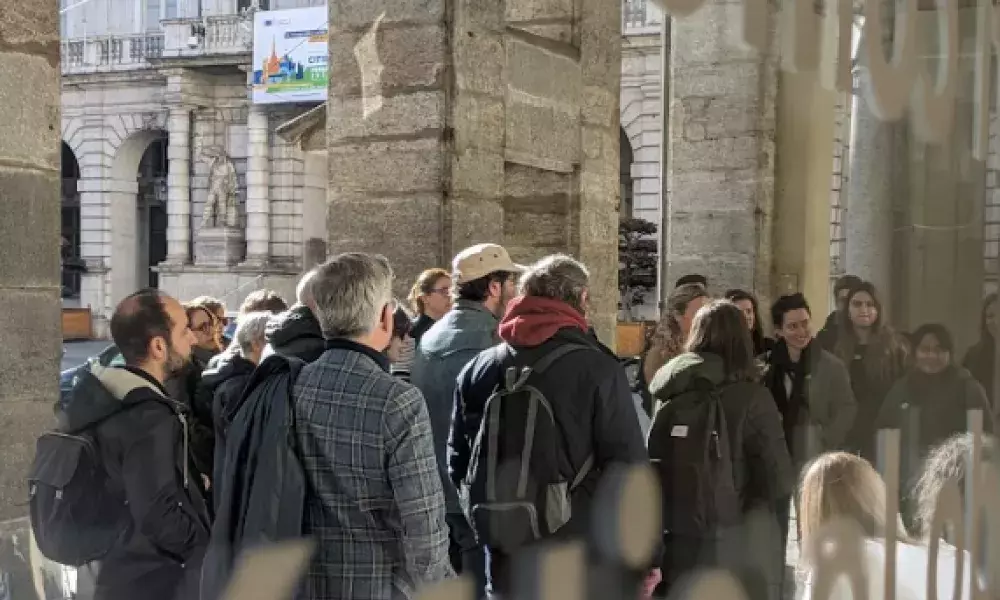
The partnership could also benefit from exchange and mutual learning activities, dialoguing with ongoing local initiatives - some of them financed under the UIA and URBACT programmes (Co-City and To-Nite; Co4Cities Transfer Network) others rooted on a more local base (Yalla Aurora, OFFTopic, Laboratori di Via Baltea, etc.) but all consistent with the principles, methodologies, approaches and contents developed in Halandri by Cultural H.ID.RA.N.T.
This zoom-in reports about what happened during the study visit, highlighting some of the main topics for discussion and exchange, focusing on the main lessons learnt and prospective reflection, and discussing about how some of the recent achievements of Cultural H.ID.RA.N.T. can inspire Torino based initiatives at the different levels.
Why Torino?
In the last thirty years, Torino has been going through a complex physical and socioeconomic transition that has transformed the whole urban system, by starting a process of innovation and change that is still underway. The EU programming has played a crucial role in this process, not only from an economic and financial point of view, but also as an incentive for the development of innovative and effective public policies which have encouraged local governments to outline new practices and set up development opportunities, by institutionalizing the new operating methods, new administrative tools and new ways of relating to citizens.
Since the first experience with complex programmes in the 1990s, Torino has been working considerably on its territorial dimension, identifying specific areas where integrating the land physical redevelopment with socio-economic regeneration and the implementation of social support measures. These actions are accurately defined and each implementation phase supported with the involvement of local actors and the coordination of choices and solutions. The innovative management models aim at safeguarding these actions in time, monitoring and looking after each neighborhood, setting up territorial partnerships capable of establishing a dialogue between institutions, third sector, enterprises and citizens.
In this larger picture, there are some specific approaches that proved as an interesting field of study for the Halandri Cultural H.ID.RA.N.T. partnership:
- LOCAL DEVELOPMENT. Planning actions with long-term transformative effects, especially on the quality of life of citizens and local communities.
- NEW FORMS OF CIVIC ENGAGEMENT. Opening decision-making processes by engaging citizens to analyze problems and solutions, planning and managing together the use of collective spaces and services, to make the city a common good.
- INTEGRATED APPROACH. Developing urban regeneration actions by combining the transformation of the city physical assets, the socio-economic revitalization of neighborhoods and the involvement of local communities
- NEW MANAGEMENT SERVICES AND MODELS. Planning new hybrid services, sharing open, participatory and horizontal management models, where the use of public resources encourages initiatives and private funding.
- GREEN TRANSITION AND URBAN POLICIES. Conceiving pilot actions and experiments in local and open contexts to achieve the ecological transition: working on replicability and scalability of actions, in order to address climate change issues integrating them into the larger urban policy making process.
- INNOVATE THE PUBLIC SECTOR. Improving administrative practice, going beyond a sector-oriented approach, integrating skills and changing organizations, in order to make local governments’ actions more effective.
- IMPLEMENT THE EUROPEAN AGENDA. The approaches, themes, and directions defined by the EU are part of the process to reach the long-term goals set out by the city policies and integrated in the planning tools.
March 2023 was an important month for Torino, as the city hosted the 5th edition of the Cities Forum. The Forum is designed to bring together key urban stakeholders at European, national, regional and local levels in exchange, mutual learning and debate activities on urban issues. The 2023 edition focused on how to build a green and just future of cities: the event was also the place and moment to discuss the urban dimension of Cohesion Policy for 2021-2027, it included the presentation of new EU level initiatives created to support cities (the official launch of the European Urban Initiative - EUI and its first EU level capacity building event), and put a spotlight on the recent developments under the key policies and initiatives which engage cities (the Urban Agenda for the EU, the EU Mission for 100 Climate Neutral and Smart Cities, the New European Bauhaus).

In the last thirty years, Torino has been going through a complex physical and socioeconomic transition that has transformed the whole urban system, by starting a process of innovation and change that is still underway. The EU programming has played a crucial role in this process, not only from an economic and financial point of view, but also as an incentive for the development of innovative and effective public policies which have encouraged local governments to outline new practices and set up development opportunities, by institutionalizing the new operating methods, new administrative tools and new ways of relating to citizens.
Since the first experience with complex programmes in the 1990s, Torino has been working considerably on its territorial dimension, identifying specific areas where integrating the land physical redevelopment with socio-economic regeneration and the implementation of social support measures. These actions are accurately defined and each implementation phase supported with the involvement of local actors and the coordination of choices and solutions. The innovative management models aim at safeguarding these actions in time, monitoring and looking after each neighborhood, setting up territorial partnerships capable of establishing a dialogue between institutions, third sector, enterprises and citizens.
In this larger picture, there are some specific approaches that proved as an interesting field of study for the Halandri Cultural H.ID.RA.N.T. partnership:
- LOCAL DEVELOPMENT. Planning actions with long-term transformative effects, especially on the quality of life of citizens and local communities.
- NEW FORMS OF CIVIC ENGAGEMENT. Opening decision-making processes by engaging citizens to analyze problems and solutions, planning and managing together the use of collective spaces and services, to make the city a common good.
- INTEGRATED APPROACH. Developing urban regeneration actions by combining the transformation of the city physical assets, the socio-economic revitalization of neighborhoods and the involvement of local communities
- NEW MANAGEMENT SERVICES AND MODELS. Planning new hybrid services, sharing open, participatory and horizontal management models, where the use of public resources encourages initiatives and private funding.
- GREEN TRANSITION AND URBAN POLICIES. Conceiving pilot actions and experiments in local and open contexts to achieve the ecological transition: working on replicability and scalability of actions, in order to address climate change issues integrating them into the larger urban policy making process.
- INNOVATE THE PUBLIC SECTOR. Improving administrative practice, going beyond a sector-oriented approach, integrating skills and changing organizations, in order to make local governments’ actions more effective.
- IMPLEMENT THE EUROPEAN AGENDA. The approaches, themes, and directions defined by the EU are part of the process to reach the long-term goals set out by the city policies and integrated in the planning tools.
March 2023 was an important month for Torino, as the city hosted the 5th edition of the Cities Forum. The Forum is designed to bring together key urban stakeholders at European, national, regional and local levels in exchange, mutual learning and debate activities on urban issues. The 2023 edition focused on how to build a green and just future of cities: the event was also the place and moment to discuss the urban dimension of Cohesion Policy for 2021-2027, it included the presentation of new EU level initiatives created to support cities (the official launch of the European Urban Initiative - EUI and its first EU level capacity building event), and put a spotlight on the recent developments under the key policies and initiatives which engage cities (the Urban Agenda for the EU, the EU Mission for 100 Climate Neutral and Smart Cities, the New European Bauhaus).

What in Torino?
The participation of the Halandri partnership to the Forum was the occasion to organize a number of side activities in Torino, taking advantage of the presence of other partnerships, delegations, UIA Experts in the field, intercepting different domains: knowledge sharing, learning and exchange, cross-fertilization, dialogue and confrontation between UIA financed projects, best practices exploration.
The participation of the Halandri partnership to the Forum was the occasion to organize a number of side activities in Torino, taking advantage of the presence of other partnerships, delegations, UIA Experts in the field, intercepting different domains: knowledge sharing, learning and exchange, cross-fertilization, dialogue and confrontation between UIA financed projects, best practices exploration.
A first nucleus of content/activities focused on Culture and Cultural Heritage, and was curated by UIA Experts in Cultural Heritage Haris Biskos, Zsuzsa Kravalik, Chiara Lucchini, Levente Polyak, Ileana Toscano. Intercepting the interest of the Cities receiving funding under the Urban Innovative Actions programme (Almeria, Halandri, Kosice, Ravenna, Tilburg, Ujbuda - Budapest) the group of experts imagined a programme of activities closely intertwined with the experiences and practices rooted in Torino, combining both UIA funded experiences (CO-CITY and the resulting Co4Cities URBACT-UIA transfer mechanism; TONITE) and other local initiatives, pilots and test-sites sharing similar approaches. Main pivotal and common concept is the role Culture and Cultural Heritage can play in engaging, activating and mobilizing citizens. Hence the exchange and cross fertilization between different projects focused on people’s networks and interconnections, open decision-making processes engaging citizens in defining problems and solutions, planning and managing together the use of collective spaces and services, making the city a common good, to finally explore how to develop urban regeneration actions by combining the transformation of the city physical assets, the socio-economic revitalization of neighborhoods and the involvement of local communities. In order to provide multiple options for discussion and exchange, as much as catching the opportunity to see the different initiatives in their making, the five experts designed a set of activities that unfolded on March 15th and included: a general introduction about Torino (taking place at Urban Lab, Torino’s City Agency); a walkshop to “operationally” get in touch with some of the experiences currently implemented in Torino, seeing them in their making (in cooperation with Kallipolis Association); a talk in two sessions to confront and debate about collaborative experiences of culture and cultural heritage as a driver for innovation in cities (1).
A second set of activities was designed specifically for the Halandri partnership, with the objective of providing the different people/organizations participating the study visit(2) opportunities for: presenting and discussing their work to different audiences, exploring local practices, exchanging with peers, establishing new connections and expanding their networks (also externally to the partnership and beyond the domain of Cultural H.ID.RA.N.T.), learning from Torino practices, design future cooperation, frame new topics and development trajectories.
This tailor made programme, unfolding from the 15th to the 17th of march, included: a public conference at Politecnico di Torino (3) - March 16th, 1-2,30 pm, @Lingotto Campus; a networking meeting between EYDAP and SMAT - Società Metropolitana Acque Torino (4) - March 17th, @Depuratore centrale SMAT in Castiglione Torinese; a BtoB meeting with CWC - City Water Circles Torino team -17th March, 2,30-3,30 pm.; an urban itinerary including site visits (via Baltea Community Hub, Alimonda Gardens, Yalla Aurora, Nuvola Lavazza, UIA To-Nite/Viale Mai intervention, Off Topic Community Hub) and conversations with local and international experts(5) and practitioners - March 17th, 3,30 to 8,30 pm.
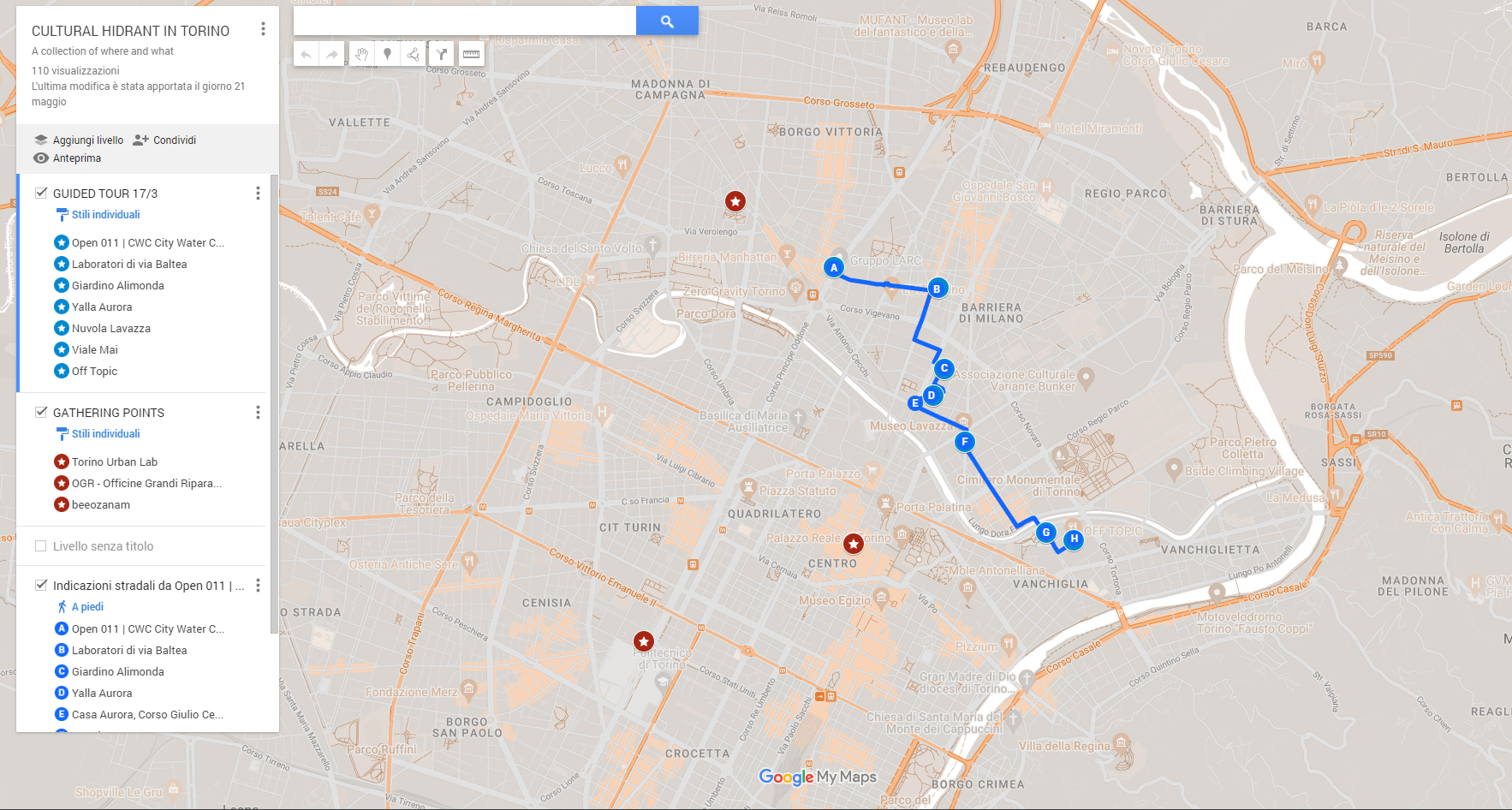
Where and how in Torino?
The manifold activities that took place in Torino offered the partnership the possibility to discuss the state of advancement of the project and its achievements with different stakeholders and at different levels. This activated a number of multiple level conversations between the different components of the delegation and Torino representatives.
The manifold activities that took place in Torino offered the partnership the possibility to discuss the state of advancement of the project and its achievements with different stakeholders and at different levels. This activated a number of multiple level conversations between the different components of the delegation and Torino representatives.
In the conference at Politecnico di Torino Dimitris Poulios from TPA - Thymio Papayannis and Associates lectured to the students, doctorate candidates and researchers about the relationship between landscape, society and culture, using the Hadrian Aqueduct and the related Cultural H.ID.RA.N.T. and Hadrian ITI initiative as hotspots into a more general reflection concerning the role Cultural and Natural can play in the design process, offering a stage for stakeholders engagement and activation. In his speech Dimitris discussed how architecture, landscape design and urbanism function as a means of transformation and change. The role of architects in cultural, landscape and environmental protection, the importance of co-designing and collaborating with local stakeholders and civil society, the difficulties that arise in this process of transformation.
Finally the New European Bauhaus initiative was called into question, as an operational perspective to frame the future challenges of the architectural practice: how to imagine and build together a sustainable and inclusive future? How to respond to needs beyond functionality? How to encourage a dialogue across cultures, disciplines, genders and ages? These bold questions activated a vivid debate with students about the social role of their (future) profession, and its potential in establishing synergies between scales and policy domains, igniting change between people and institutions.
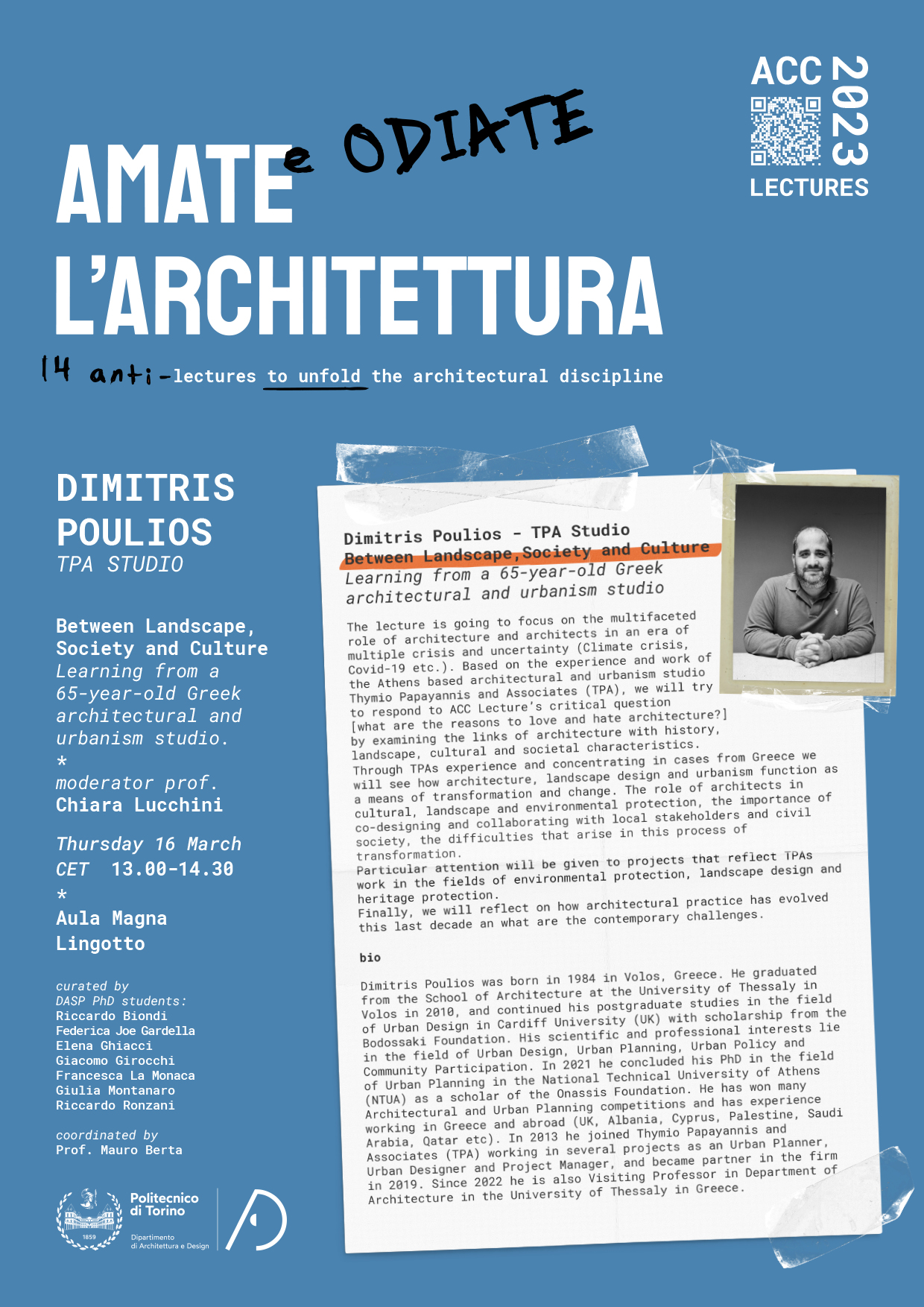
The exchange continued with the BtoB meeting with CWC - City Water Circles local team. CWC is a Interreg Europe funded project aiming to help municipalities to reform outdated urban water infrastructure systems via applying a circular economy approach. All representatives of the Halandri partnership visited the Torino CWC test site at Open 011, where a pilot action was started to demonstrate rainwater retention and attenuation by applying different nature-based solutions (NBSs) to deal with rainwater in an urban context. In addition, it develops a rooftop farming strategy as a solution for the resilient city of tomorrow: in fact the building’s big terrace is used as a rooftop garden including an adjacent aeroponic greenhouse, which is irrigated with harvested rainwater. The overflow is diverted into a rain garden positioned at the entrance of the building. Harvested rainwater from approx. 325 m² of roof surfaces is reused to irrigate the rooftop garden and a greenhouse aeroponic system, whereas the overflow is diverted to irrigate the rain garden.
The pilot action helped Torino and other public authorities further implement its strategy for the green infrastructure (“Piano strategico dell’infrastruttura verde” adopted in december 2020) and its Climatic Resiliency plan (“Piano di Resilienza Climatica” - adopted in july 2020). Furthermore, with CWC the City of Torino delivered its strategic plan for urban water management. Adopted in march 2022 the plan aims at introducing water efficiency measures with the reuse of unconventional local water resources, such as rainwater and greywater (mainly wastewater used for personal hygiene) for public, domestic and industrial purposes, in order to reduce water consumption. The objective is to relieve the pressure on overexploited water resources within the urban area, while the reuse of rainwater will also make it possible to reduce the negative impact of intense weather events.
Jointly with the networking meeting between EYDAP and SMAT, this site visit helped activate an exchange concerning the management and use of urban waters, with the definition of strategies helping the public bodies promote a new culture of water preservation, recycling and reuse: to be implemented at local level by public institutions, this new approach should also be spread among citizens and stakeholders with dedicated tools (public communication and engagement campaigns, incentives, etc.).
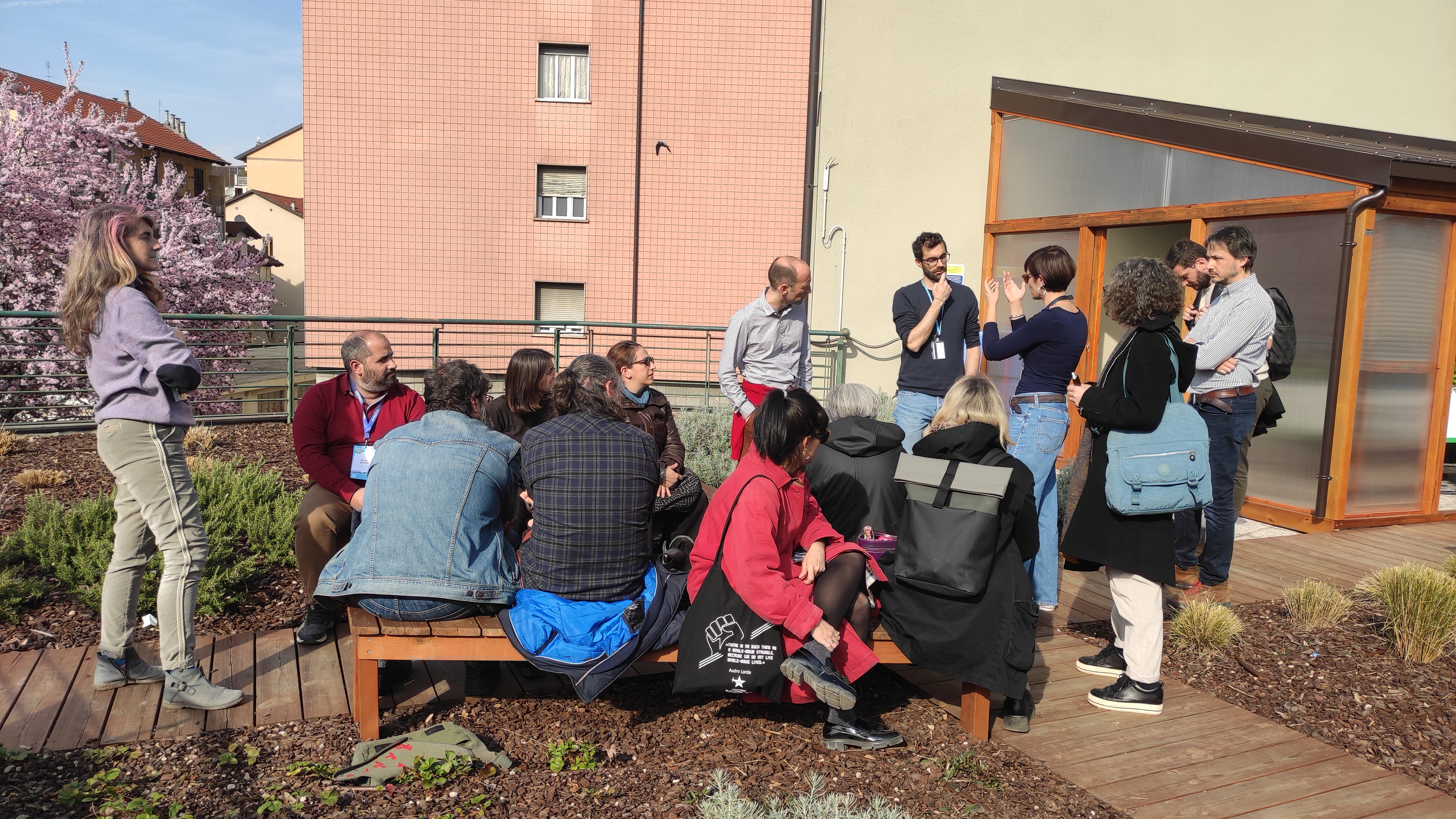
An urban itinerary including site visits and conversations with local and international experts concluded the study visit. The focus of this long walk across the northern part of the city was the relationship between urban regeneration actions and the activation of citizens and communities in the process of change. The itinerary crossed Aurora and Barriera di Milano neighborhoods, between the poorest, younger and more mixed parts of the city currently undergoing a relevant (and somehow controversial) process of change. During the last decade (and in the forthcoming years) a number of plans, programmes, policies and investments concentrated in the area: four different investment programs and 9 strategic projects are bringing more than 10M € to this portion of the city (from 2024 onwards another 20M € are foreseen). Actions span from public space recovery to the introduction of nature based solutions (NBS), from the enhancement of public transport to interventions on the green areas and on the roads. Proximity services are also included, while the physical transformation intertwines with socioeconomic development: the idea is to combine the regeneration action to civic involvement and social innovation, seizing the most critical situations, working on inclusion, the improvement of public space, social relationships and quality of life, strengthening the communities, improving the quality of life, reducing the inequalities.
The urban itinerary coupled critical walking - a mode of expression and a useful instrument for learning about the ongoing social and morphological transformations in cities - and conversations with community managers, neighborhood ambassadors and antennas, to share first hand experience on practices and concrete actions put in place in the area:
- via Baltea Community Hub, where cooperative work based on food, circularity and responsible consumption is the key to empower migrants;
- the Alimonda gardens where a couple of retired former blue collars renewed a volleyball playfield for their grandchildren and the neighborhood’s kids;
- Yalla Aurora muslim youth center, that promotes italian and european citizenship amongst the second generation migrants;
- Community-based urban security interventions promoted by the UIA funded TO-NITE project;
- Off-TOPIC community Hub where culture based initiatives shape a rapidly changing neighborhood, establishing connections between new populations (students, migrants), old institutions (the Università degli Studi di Torino main campus stands in the area as much as quite an important public housing precinct), newly built public spaces (the viale Ottavio Mai realized with UIA funded TO-NITE project).

These rich and inspiring experiences reap the fruits, conceptually connect and operationally interact with two of the most interesting and significant policies implemented by the city of Torino in the last decades: the neighborhood houses and the pacts of collaboration (urban commons regulation). The neighborhood houses are public spaces open to citizens of all ages, offering many different initiatives: cultural events, personal services, consultancy, catering and much more. Based on the Cascina Roccafranca model, the 8 Neighbourhood Houses currently existing in Torino have been facilitating, enhancing and implementing active citizenship. The houses are privileged places of proximity, participation and construction of social ties, regeneration of urban commons, engagement and empowerment of citizens. Their daily action is aimed at: 1) encouraging active participation in the social and cultural life of both the neighborhood and the city; 2) accompanying people and organizations who intend to promote projects, events and activities in the houses’ spaces; 3) providing skills, spaces, tools and resources to ensure that realization occurs in an adequate, satisfactory manner and with an ever-increasing level of autonomy and self-organization.
The pact of collaboration is the tool through which the City of Torino and the local actors define and co-design the programme for the regeneration, care and shared management of an administration property. The agreement is based on mutual responsibility and trust and is signed by active citizens and the City (6). Torino has long experimented with urban policy tools and interventions in which inhabitants use and take care of public spaces, promote activities, workshops or imagine new use: more than 60 pacts of collaboration (including one signed for piazza Alimonda, and the obese signed in the framework of UIA financed TO-NITE project) are the demonstration of an active commitment in civic protagonism and participation that needs hybrid opportunities and contexts to emerge. The governance of the urban commons is a challenge for the administrative and operational flows of local government, both in terms of public policy building and of citizens' action to reclaim public and collective spaces.
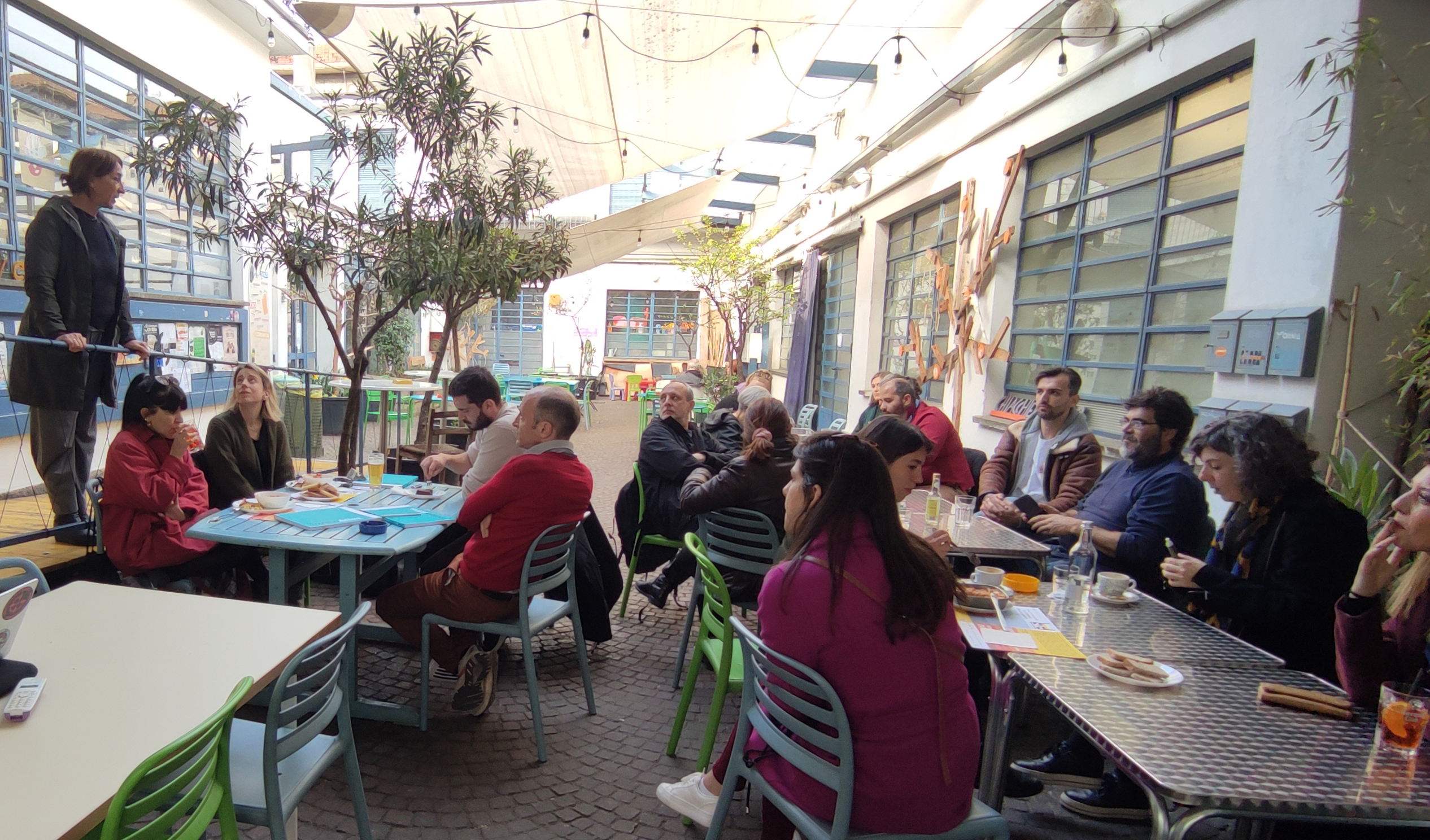
Mutual learning, and future exchange
The intense programme of activities prepared for the Halandri delegation was actually an opportunity for mutual learning, offering the possibility not only to the Cultural H.ID.RA.N.T. team to experience new practices and expand their knowledge, but also to the local groups that are working in Torino to see what they do in a different perspective. Some domains in particular were discussed, and emerged as relevant common fields for future confrontation/cooperation on methodologies and approaches:
STRATEGIES AND PILOTING. Both in the Cultural H.ID.RA.N.T. activities and in many of the practices visited in Torino there is a strong binding between piloting - testing and implementing concrete solutions, evaluating the generated outputs along the development and after - and the definition of city strategies in the long run. This is particularly clear when it comes to the CWC project in Torino, where the work on the test site generates fresh knowledge for the drafting of the strategic document on water and water management in the city. This mechanism can be of interest for the city of Halandri that, with the forthcoming completion of the physical component of the urban regeneration project, will have the chance to frame the new pocket squares into a wider policy more generally related to the quality of public spaces in the city.
UPSCALING & REPLICABILITY. Piloting is also very much related with the strive to replicate and upscale solutions, upscaling them in portions of the city or, as in the case of Halandri and the Hadrian ITI, replicating them in the surrounding municipalities. Cultural H.ID.RA.N.T. actually incorporated the transferability and replication options in its DNA, as the possibility to extend both the water network and the community-led management approach to the other municipalities of the area was clarified since the application phase. This influenced the way the initial pilot has been framed, stimulating the exchange with neighboring municipalities and other potentially engaged parties, finally integrating the reflection on replicability in all the design phases. As far as upscaling is concerned, the gradual approach to the Halandri community, the definition of clear basic requirements for accessing the service, the engagement of potential users since the early stages, allowed for the definition of a more robust and forward looking management scheme.
MAPS, DATA & DIGITAL TOOLS. In order for pilots to inform strategies, for strategies to “land” properly on a territory, and for policies to be implemented, knowledge of the context plays a key role. This issue has long been discussed during the study visit, where some examples of maps and data visualizations related to Torino were shown and introduced as tools for decision and policy making. Data-driven planning and decisions are not simply based on owning and producing data, but need to be incorporated into dedicated tools able to make data accessible, understandable and usable. The Geografie Metropolitane platform proved as a stimulating example for the Halandri delegation: describing Torino and its metropolitan area by relating the physical and socio-economic dimension in maps and dynamic infographics, the platform georeferences the urban phenomena, making them accessible to a wider audience. This sort of tools can be offered to those who intend to consult elaborations, open data and cartographic representations for purposes of public communication, storytelling, information, promotion of the local system, but also support for urban analyzes and planning activities.
STORYTELLING. Data, databases, systematized information made accessible via digital tools, are also very important in spreading and disseminating new messages and approaches, and definitely can play a role in promoting behavioral change and letting new shared knowledge emerge. Besides a more touristic approach (i.e. the Tellingstones app, used in UIA financed TO-NITE project), the Local History Archive recently activated in Halandri works in this direction, acting as a reference point and access to available resources on Hadrian Aqueduct and on the local history. It operates to trigger the production of new citizen-led knowledge about the city’s history, promoting the participative and collective making of the digital archive, spreading a new narrative concerning water, igniting a strong engagement of the local community.
COMMONS AND COMMUNITY. In recent decades, the notion of commons and urban commons has entered the public debate in European countries. Through heterogeneous initiatives, started and managed both inside and outside the public administration by formal and informal actors, these practices define a relevant common ground for discussion and exchange between Torino and Halandri. Torino’s Urban Commons Regulation and Halandri’s water community tackle crucial questions such as how to sustainably and equally implement urban policies, testing solutions and new practices. Furthermore (and more importantly) both try also to experiment in a very pragmatic and operational way on how to establish more open processes, embedding them in the administrative, financial, istitutional and procedural life of the city… and finally showing these approaches could become the “new normal”.
The intense programme of activities prepared for the Halandri delegation was actually an opportunity for mutual learning, offering the possibility not only to the Cultural H.ID.RA.N.T. team to experience new practices and expand their knowledge, but also to the local groups that are working in Torino to see what they do in a different perspective. Some domains in particular were discussed, and emerged as relevant common fields for future confrontation/cooperation on methodologies and approaches:
NOTES
(1) The group of experts reported on this in the collaborative article “Study visit & Talk: Culture and Cultural Heritage Cities”.
(2) The delegation consisted of 4 people from the Municipality of Halandri, 1 representative of Commonspace, 1 for EYDAP (Athens Water Supply and Sewerage Company), 2 representatives of TPA- Thymio Papayannis and Associates Inc., 1 representative of Medina (Mediterranean Institute for Nature and Anthropos), 1 representative of RDI (Regional Development Institute – Panteion University), 1 representative of Ohi Pezoume Performing Arts.
(3) The lecture was organized in cooperation with the School of Doctorate Studies of Politecnico di Torino (PhD in “Architecture, History and Project”), in the framework of the ACC Lectures 2023.
(4) George Sachinis from EYDAP met Armando Quazzo (CEO SMAT Torino) and Daniel Novarino (Director of SMAT Depuration Plant). The meeting was dedicated to explore potential cooperation between the two institutions, and included a visit to the Depuratore Centrale (SMAT treatment plant in Castiglione Torinese: one of the largest in Europe, serving 44 municipalities in the Torino metropolitan area and collecting 8,000 km of sewage networks).
(5) he urban itinerary was organized in cooperation with the local team of UIA financed To-Nite project, it engaged local association representatives and was opened to local, national and international experts, practitioners and researchers. Participants: Elisa Copertino and Stefano Di Polito (TO- NITE UIA financed project), Simone D’Antonio (URBACT Italia, TO-NITE UIA Financed Project), Daniele Terzariol (Deputy Mayor for Budget, City of San Donà di Piave and URBACT expert), Carlo Salone and Giovanni Semi (Università degli Studi di Torino - DIST Dipartimento Interateneo Territorio), Francesca Frassoldati (Politecnico di Torino DAD - Dipartimento di Architettura e Design), Anna Rowinski and Sara Medici (via Baltea Community Hub), Vittoriano Taus (Arqa Association), Brahim Baya (Associazione Islamica delle Alpi), Daniele Citriniti (Off Topic Community Hub).
(6) In order to promote and test the Pacts of collaboration, in 2017 Torino started Co-City, an innovative project for the shared management of common goods, financed by UIA - Urban Innovative Actions. In 2021, the CO4CITIES project was launched, in the framework of the UIA - URBACT Transfer Mechanism, with the goal of transferring the methodology developed through Co-City and conceiving new prospects of collaboration in Torino.
About this resource
The Urban Innovative Actions (UIA) is a European Union initiative that provided funding to urban areas across Europe to test new and unproven solutions to urban challenges. The initiative had a total ERDF budget of €372 million for 2014-2020.
Similar content




